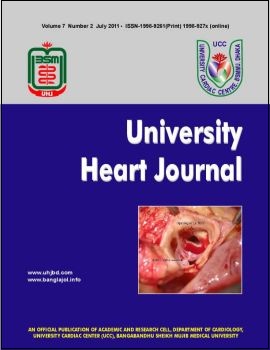Correlation of Angiographic Findings between Right (V1 to V3) versus left (V4 to V6) Precordial ST Segment Depression in Acute Inferior Myocardial Infarction
DOI:
https://doi.org/10.3329/uhj.v7i2.10839Keywords:
Inferior Myocardial Infarction, ST depression, Electrocardiogram, Coronary artery diseaseAbstract
The initial ECG in patients with acute inferior MI may have a great value to identify the subgroup of patients who are at high risk by predicting multivessel coronary artery disease (CAD). These patients, therefore, may benefit from a more invasive approach. ST segment depression in leads V4 to V6 but not V1 to V3 confers a greater likelihood of multivessel CAD. The aim of the study to correlate between ST-depression in ECG on admission & severity of coronary lesion in angiogram in acute inferior MI. This study was undertaken in the department of cardiology of Bangabandhu Sheikh Mujib Medical University and in Ibrahim Cardiac Hospital & Research Institute from March 2009 to October 2010. Patients (total 93) of acute inferior MI, who were presented within 12hrs of onset of symptoms and got intravenous thrombolytics were divided into three groups after initial ECG, group A-without precordial ST-segment depression, group B- maximal precordial STsegment depression in leads V1V3 and group C- maximal precordial ST-segment depression in leads V4 V6.CAG was done within six weeks of MI and findings of CAG were compared among the groups. Age, sex, distribution of risk factors were identical among the groups. Significant number (53.8%) of patients in group C had a lower ejection fraction (LVEF< 50%) than group B (30%) and group A (10.8%) (p=0.001). Patients of group C more often had double vessel disease (38.5% p=0.007) and triple vessel disease (30.8%) (p=0.014). In contrast, single vessel disease was more common in group B (80%) (p=0.001). Involvement of LAD was also significantly higher in group-C (73.1% p= 0.001). Left precordial ST depression (lead V4-V6) correlates with multivessel CAD, a trend toward a higher rate of LAD artery disease and is associate with LV dysfunction.
DOI: http://dx.doi.org/10.3329/uhj.v7i2.10839
University Heart. Journal Vol. 7, No. 2, July 2011
Downloads
155
158

